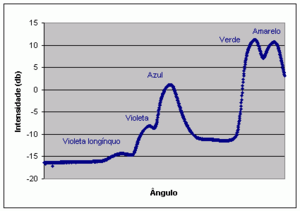Difference between revisions of "Planck's Constant Determination"
(Texto inicial (incompleto)) |
(Mais texto (títulos)) |
||
| Line 51: | Line 51: | ||
# The experiment will automatically turn the mercury bulb off after 30min. After this happens, there is a 15min waiting period to stabilize the power running through the bulb. | # The experiment will automatically turn the mercury bulb off after 30min. After this happens, there is a 15min waiting period to stabilize the power running through the bulb. | ||
# It is important to use the correct filter to avoid the superposition of two colours in the photocell, something that can occur because of diffusion of light. | # It is important to use the correct filter to avoid the superposition of two colours in the photocell, something that can occur because of diffusion of light. | ||
| + | |||
| + | |||
| + | ==Plank's Constant Determination== | ||
| + | Under construction. | ||
| + | <!-- | ||
| + | By running the experiment in NORMAL mode, the output will be the time caracteristic of the capacitor's charge, | ||
| + | --> | ||
| + | |||
| + | =Advanced Protocol= | ||
| + | Under construction. | ||
| + | |||
| + | |||
| + | ==Classic model for radiation and particle model== | ||
| + | Under construction. | ||
| + | |||
| + | |||
| + | =Theoretical Principles= | ||
| + | Under construction. | ||
| + | |||
| + | |||
| + | ==Photoelectric Effect== | ||
| + | Under construction. | ||
| + | |||
| + | |||
| + | =Historical Elements= | ||
| + | In 1921, Albert Einstein won the Nobel Physics Prize for his discovery of the law of photoelectric effect. | ||
Revision as of 21:37, 27 May 2012
Contents
Description of the Experiment
The purpose of this experiment is to study the photoelectric effect in metal and the determination of Plank's constant, since the former is of a quantic nature.
The light created by a mercury bulb is passed through a diffraction net to separate its spectral lines (i.e., the colours of the spectrum, just as a rainbow is a separation of the sunlight) and is used to force the emission of electrons in a photoelectric cell for each colour.
Experimental Apparatus
Under construction.
Protocol
There are two steps to achieve the goals of this experiment:
- Identify the angle for which the spectral lines are visible;
- Select the line to analyse and the filters to avoid reflected light with different wavelenghts.
To identify the lines, the experiment must first be done in sweep mode. This way, the output of phototransistor will show what are the angles that have light. The order of the peaks is shown in table 1
| Colour | Frequency (Hz) | Approximate wavelength (nm) |
|---|---|---|
| Violeta longínquo | 8.22x1014 | 365 |
| Violeta | 7.41x1014 | 405 |
| Azul | 6.88x1014 | 436 |
| Verde | 5.49x1014 | 546 |
| Amarelo | 5.19x1014 | 578 |
Obs:
- The experiment will automatically turn the mercury bulb off after 30min. After this happens, there is a 15min waiting period to stabilize the power running through the bulb.
- It is important to use the correct filter to avoid the superposition of two colours in the photocell, something that can occur because of diffusion of light.
Plank's Constant Determination
Under construction.
Advanced Protocol
Under construction.
Classic model for radiation and particle model
Under construction.
Theoretical Principles
Under construction.
Photoelectric Effect
Under construction.
Historical Elements
In 1921, Albert Einstein won the Nobel Physics Prize for his discovery of the law of photoelectric effect.
